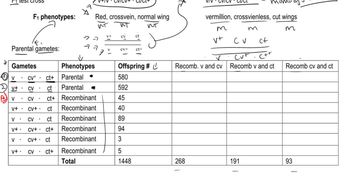The wild-type allele of a gene has an A–T base pair at a particular location in its sequence, and a mutant allele of the same gene has a G–C base pair at the same location. Otherwise, the sequences of the two alleles are identical. Does this information tell you anything about the dominance relationship of the alleles? Explain why or why not.
Table of contents
- 1. Introduction to Genetics51m
- 2. Mendel's Laws of Inheritance3h 37m
- 3. Extensions to Mendelian Inheritance2h 41m
- 4. Genetic Mapping and Linkage2h 28m
- 5. Genetics of Bacteria and Viruses1h 21m
- 6. Chromosomal Variation1h 48m
- 7. DNA and Chromosome Structure56m
- 8. DNA Replication1h 10m
- 9. Mitosis and Meiosis1h 34m
- 10. Transcription1h 0m
- 11. Translation58m
- 12. Gene Regulation in Prokaryotes1h 19m
- 13. Gene Regulation in Eukaryotes44m
- 14. Genetic Control of Development44m
- 15. Genomes and Genomics1h 50m
- 16. Transposable Elements47m
- 17. Mutation, Repair, and Recombination1h 6m
- 18. Molecular Genetic Tools19m
- 19. Cancer Genetics29m
- 20. Quantitative Genetics1h 26m
- 21. Population Genetics50m
- 22. Evolutionary Genetics29m
2. Mendel's Laws of Inheritance
Probability and Genetics
Problem 37
Textbook Question
A true-breeding purple-leafed plant isolated from one side of El Yunque, the rain forest in Puerto Rico, was crossed to a true-breeding white variety found on the other side. The F₁ offspring were all purple. A large number of F₁ x F₁ crosses produced the following results:
purple: 4219, white: 5781 (Total = 10,000)
Propose an explanation for the inheritance of leaf color. As a geneticist, how might you go about testing your hypothesis? Describe the genetic experiments that you would conduct.
 Verified step by step guidance
Verified step by step guidance1
Step 1: Analyze the F₁ generation results. Since all F₁ offspring are purple, this suggests that the purple trait is dominant over the white trait. This indicates that the purple-leafed parent likely contributed a dominant allele (P), while the white-leafed parent contributed a recessive allele (p). The F₁ genotype is therefore heterozygous (Pp).
Step 2: Examine the F₁ x F₁ cross results. The observed ratio of purple (4219) to white (5781) is approximately 3:4. This deviates from the classic Mendelian 3:1 ratio expected for a single-gene inheritance pattern. This suggests that more than one gene may be involved in determining leaf color.
Step 3: Propose a hypothesis. Based on the observed ratio, hypothesize that leaf color is controlled by two genes with epistatic interactions. For example, one gene may determine whether pigment is produced (e.g., P for pigment, p for no pigment), and another gene may modify the pigment color (e.g., C for purple, c for white).
Step 4: Design a genetic experiment to test the hypothesis. Perform a test cross by crossing F₁ individuals (PpCc) with a homozygous recessive individual (ppcc). Analyze the phenotypic ratios of the offspring to determine if they align with the proposed two-gene model. Use a Punnett square to predict the expected ratios for comparison.
Step 5: Conduct further experiments to confirm the genetic basis. Perform complementation tests and analyze the segregation patterns in subsequent generations. Additionally, use molecular techniques such as gene sequencing or marker analysis to identify the specific genes involved and confirm their roles in leaf color determination.
 Verified video answer for a similar problem:
Verified video answer for a similar problem:This video solution was recommended by our tutors as helpful for the problem above
Video duration:
2mPlay a video:
Was this helpful?
Key Concepts
Here are the essential concepts you must grasp in order to answer the question correctly.
Mendelian Inheritance
Mendelian inheritance refers to the principles of heredity established by Gregor Mendel, which include the concepts of dominant and recessive traits. In this case, the purple leaf color is likely a dominant trait, as all F₁ offspring exhibited purple leaves when crossed with a true-breeding white variety. The observed 3:1 ratio of purple to white in the F₂ generation supports this model, indicating that the purple allele masks the expression of the white allele.
Recommended video:
Guided course

Organelle Inheritance
Genotype and Phenotype
The genotype is the genetic makeup of an organism, while the phenotype is the observable physical or biochemical characteristics. In this scenario, the genotype of the true-breeding purple plant is homozygous dominant (PP), and the white plant is homozygous recessive (pp). The F₁ generation, being heterozygous (Pp), displays the purple phenotype, demonstrating how genotype influences phenotype in inheritance patterns.
Recommended video:
Guided course

Gamete Genotypes
Test Cross
A test cross is a genetic experiment used to determine the genotype of an organism exhibiting a dominant phenotype. By crossing the purple-leafed plant (Pp) with a homozygous recessive plant (pp), one can observe the phenotypic ratios in the offspring. If any offspring display the recessive phenotype, it indicates that the purple plant is heterozygous; if all offspring are purple, the plant is likely homozygous dominant.
Recommended video:
Guided course

Trihybrid Cross
Related Videos
Related Practice
Textbook Question
405
views


